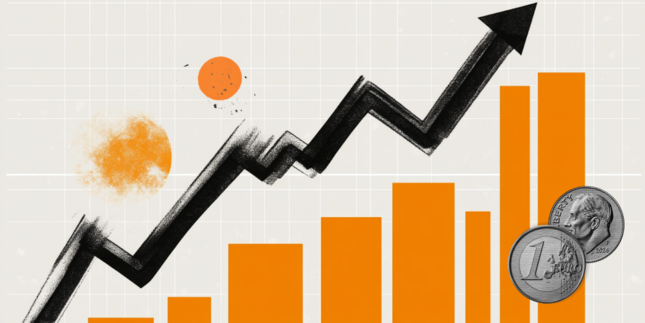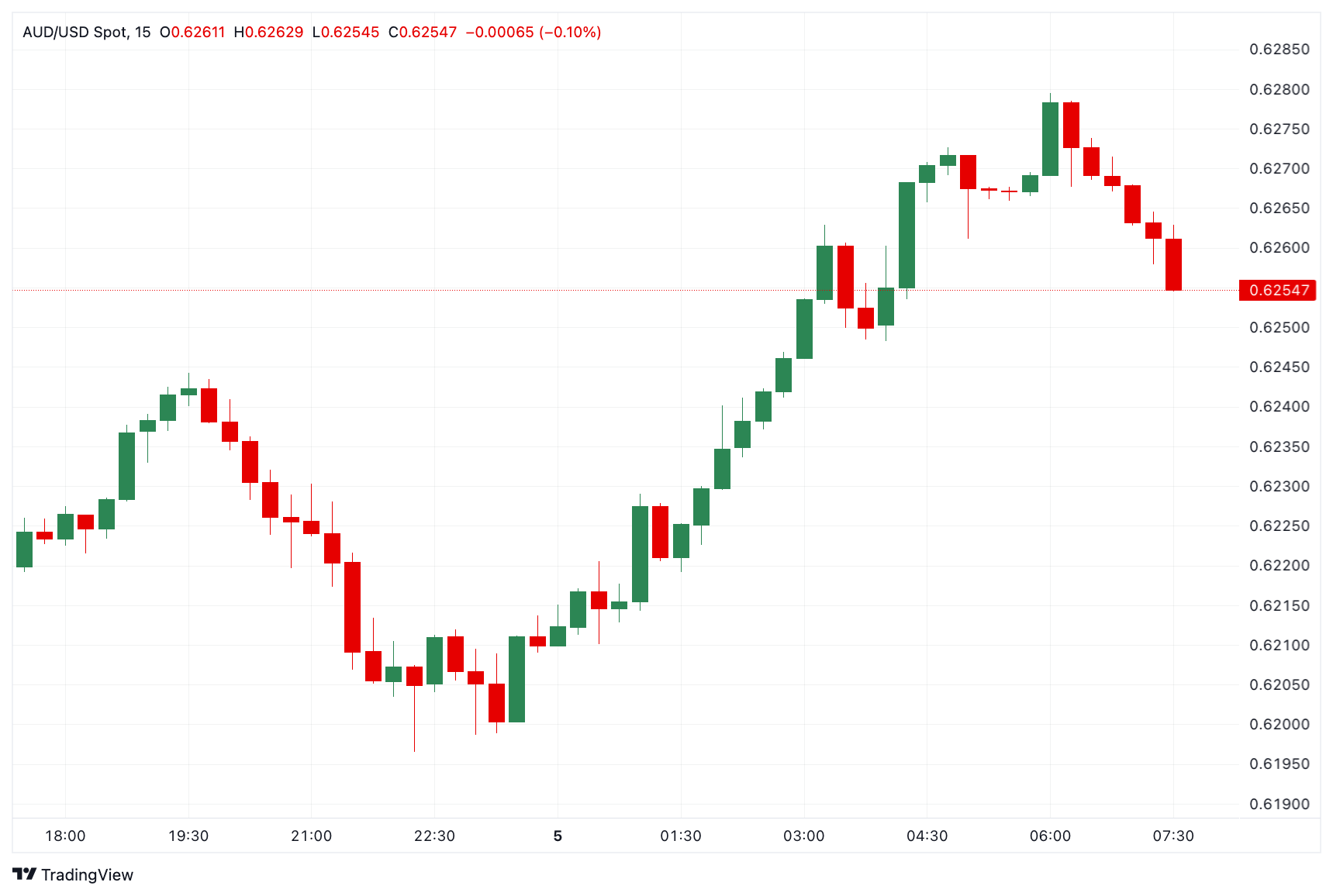Australia’s Gross Domestic Product (GDP) grew 0.6% QoQ in the fourth quarter (Q4) of 2024 compared with the 0.3% growth in the third quarter, the Australian Bureau of Statistics (ABS) showed on Wednesday. This reading came in above expectations of 0.5%.
The annual fourth-quarter GDP expanded by 1.3%, compared with the 0.8% growth in Q3 while above the consensus of a 1.2% increase.
Additional takeaways from the Australian GDP data
In nominal terms, GDP rose 1.6%.
The terms of trade rose 1.7%.
Household saving to income ratio rose to 3.8% from 3.6%.
Market reaction to Australia’s GDP data
The upbeat Australia GDP report fails to boost the Australian Dollar (AUD). The AUD/USD pair is trading at 0.6258, adding 0.12% on the day.
AUD/USD 15-minute chart
This section below was published at 21.45 GMT on Wednesday as a preview of the Australia's Gross Domestic Product report
- Australian Gross Domestic Product is foreseen at 0.5% in the last quarter of 2024.
- The Reserve Bank of Australia hinted at a cautious approach to interest rate cuts.
- The Australian Dollar could run towards 0.6300 vs the USD on an upbeat GDP report.
The Australian Gross Domestic Product (GDP) will be out early on Wednesday. The fourth quarter (Q4) figures released by the Australian Bureau of Statistics (ABS) are expected to show that the economy made modest progress in the last three months of 2024. The quarter-on-quarter (QoQ) GDP is foreseen at 0.5%, improving from the 0.3% posted in the previous quarter, while the annualised reading is foreseen at 1.2% after posting 0.8% in Q3.
Slow progress in Australia is partially due to the Reserve Bank of Australia (RBA), as the central bank decided to maintain interest rates on hold at multi-decade highs throughout 2024 to fight stubbornly high inflation.
What to expect from the Q4 GDP report
As said, the Australian economy is expected to have posted a modest 1.2% annualised growth in the last quarter of 2024. GDP data tends to impact significantly the local currency, in this case, the Australian Dollar (AUD).
However, financial markets may take the figures with a pinch of salt. Indeed, record interest rates have weighed on economic developments, yet the RBA finally delivered an interest rate cut in its early February meeting. The Official Cash Rate (OCR) now stands at 4.1%, down 25 basis points (bps) from 4.35%, which means the impact of higher interest rates should start to recede. It will be a long process, but at least the Board took a first step, boosting investors’ hopes.
With time, rate reductions should help stabilise growth around long-term trends while keeping inflation within target. It is worth noting that real GDP per capita fell for seven consecutive quarters as of Q3 2024, driven by restricted household spending amid higher rates.
Meanwhile, it is also worth remembering that the RBA has had a cautious approach to interest rate cuts. The recently released Minutes showed the Board “was not yet assured” inflation could be returned to the target range with a lower OCR. “As a result, members expressed caution about the prospect of further policy easing, which could also be seen in the forecast for inflation based on the market path,” the document reads.
Ahead of the announcement, analysts from the Westpac Banking Corporations noted: “We have upgraded our forecast of economic growth following the latest batch of partial activity indicators in the run-up to Q4 GDP, due tomorrow. We now expect the economy grew by 0.7% in Q4, up from our initial estimate of 0.4% in our preview last week. The upside surprise on business inventories was met with a lower-than-anticipated growth in imports, albeit with some of the latter pointing to slightly softer domestic demand.”
At the same time, the National Australian Bank (NAB) expects a GDP print of 0.5% QoQ and 1.2% YoY. “We continue to expect GDP growth to strengthen over 2025 making H2 2024 the low point in growth for the cycle.”
How can the GDP report affect the Australian Dollar?
The GDP report will be released on Wednesday at 00:30 GMT. Ahead of the release, the Australian Dollar (AUD) struggles to advance against its American rival. The US Dollar (USD) is under selling pressure amid fresh fears of a United States (US) economic slowdown following US President Donald Trump’s decision to go on with tariffs on Canada, Mexico and China. At the same time, a risk-averse environment weighs on the Aussie, leaving the AUD/USD pair within familiar levels.
Generally speaking, upbeat figures should boost the AUD, while a slide should be expected if numbers miss expectations.
Valeria Bednarik, Chief Analyst at FXStreet, notes: “The AUD/USD pair trades just above the 0.6200 mark ahead of the announcement, trapped between USD broad weakness and risk aversion. The daily chart suggests bears retain control, albeit slides towards the 0.6200 figure are attracting buyers. The intraday low following Trump’s levies was set at 0.6201. The latter could give up on a discouraging GDP outcome and result in a slide towards the 0.6100-0.6130 region, as the dismal mood will add to the bearish case.”
Bednarik adds: “Stronger-than-anticipated Australian growth could help AUD/USD run past 0.6253, the weekly high, and reach the 0.6300 threshold. Beyond the latter, resistance comes at 0.6330 and 0.6370.”
Economic Indicator
Gross Domestic Product (QoQ)
The Gross Domestic Product (GDP), released by the Australian Bureau of Statistics on a quarterly basis, is a measure of the total value of all goods and services produced in Australia during a given period. The GDP is considered as the main measure of Australian economic activity. The QoQ reading compares economic activity in the reference quarter to the previous quarter. Generally, a rise in this indicator is bullish for the Australian Dollar (AUD), while a low reading is seen as bearish.
Read more.Next release: Wed Jun 04, 2025 01:30
Frequency: Quarterly
Consensus: -
Previous: 0.6%
Source: Australian Bureau of Statistics
The Australian Bureau of Statistics (ABS) releases the Gross Domestic Product (GDP) on a quarterly basis. It is published about 65 days after the quarter ends. The indicator is closely watched, as it paints an important picture for the economy. A strong labor market, rising wages and rising private capital expenditure data are critical for the country’s improved economic performance, which in turn impacts the Reserve Bank of Australia’s (RBA) monetary policy decision and the Australian dollar. Actual figures beating estimates is considered AUD bullish, as it could prompt the RBA to tighten its monetary policy.
GDP FAQs
A country’s Gross Domestic Product (GDP) measures the rate of growth of its economy over a given period of time, usually a quarter. The most reliable figures are those that compare GDP to the previous quarter e.g Q2 of 2023 vs Q1 of 2023, or to the same period in the previous year, e.g Q2 of 2023 vs Q2 of 2022. Annualized quarterly GDP figures extrapolate the growth rate of the quarter as if it were constant for the rest of the year. These can be misleading, however, if temporary shocks impact growth in one quarter but are unlikely to last all year – such as happened in the first quarter of 2020 at the outbreak of the covid pandemic, when growth plummeted.
A higher GDP result is generally positive for a nation’s currency as it reflects a growing economy, which is more likely to produce goods and services that can be exported, as well as attracting higher foreign investment. By the same token, when GDP falls it is usually negative for the currency. When an economy grows people tend to spend more, which leads to inflation. The country’s central bank then has to put up interest rates to combat the inflation with the side effect of attracting more capital inflows from global investors, thus helping the local currency appreciate.
When an economy grows and GDP is rising, people tend to spend more which leads to inflation. The country’s central bank then has to put up interest rates to combat the inflation. Higher interest rates are negative for Gold because they increase the opportunity-cost of holding Gold versus placing the money in a cash deposit account. Therefore, a higher GDP growth rate is usually a bearish factor for Gold price.
The Australian Bureau of Statistics (ABS) releases the Gross Domestic Product (GDP) on a quarterly basis. It is published about 65 days after the quarter ends. The indicator is closely watched, as it paints an important picture for the economy. A strong labor market, rising wages and rising private capital expenditure data are critical for the country’s improved economic performance, which in turn impacts the Reserve Bank of Australia’s (RBA) monetary policy decision and the Australian dollar. Actual figures beating estimates is considered AUD bullish, as it could prompt the RBA to tighten its monetary policy.
Information on these pages contains forward-looking statements that involve risks and uncertainties. Markets and instruments profiled on this page are for informational purposes only and should not in any way come across as a recommendation to buy or sell in these assets. You should do your own thorough research before making any investment decisions. FXStreet does not in any way guarantee that this information is free from mistakes, errors, or material misstatements. It also does not guarantee that this information is of a timely nature. Investing in Open Markets involves a great deal of risk, including the loss of all or a portion of your investment, as well as emotional distress. All risks, losses and costs associated with investing, including total loss of principal, are your responsibility. The views and opinions expressed in this article are those of the authors and do not necessarily reflect the official policy or position of FXStreet nor its advertisers. The author will not be held responsible for information that is found at the end of links posted on this page.
If not otherwise explicitly mentioned in the body of the article, at the time of writing, the author has no position in any stock mentioned in this article and no business relationship with any company mentioned. The author has not received compensation for writing this article, other than from FXStreet.
FXStreet and the author do not provide personalized recommendations. The author makes no representations as to the accuracy, completeness, or suitability of this information. FXStreet and the author will not be liable for any errors, omissions or any losses, injuries or damages arising from this information and its display or use. Errors and omissions excepted.
The author and FXStreet are not registered investment advisors and nothing in this article is intended to be investment advice.
Recommended content
Editors’ Picks

EUR/USD keeps the range bound trade near 1.1350
After bottoming near the 1.1300 level, EUR/USD has regained upward momentum, pushing toward the 1.1350 zone following the US Dollar’s vacillating price action. Meanwhile, market participants remain closely tuned to developments in the US-China trade war.

GBP/USD still well bid, still focused on 1.3200
The Greenback's current flattish stance lends extra support to GBP/USD, pushing the pair back to around the 1.3200 level as it reaches multi-day highs amid improved risk sentiment on Monday.

Gold trades with marked losses near $3,200
Gold seems to have met some daily contention around the $3,200 zone on Monday, coming under renewed downside pressure after hitting record highs near $3,250 earlier in the day, always amid alleviated trade concerns. Declining US yields, in the meantime, should keep the downside contained somehow.

Six Fundamentals for the Week: Tariffs, US Retail Sales and ECB stand out Premium
"Nobody is off the hook" – these words by US President Donald Trump keep markets focused on tariff policy. However, some hard data and the European Central Bank (ECB) decision will also keep things busy ahead of Good Friday.

Is a recession looming?
Wall Street skyrockets after Trump announces tariff delay. But gains remain limited as Trade War with China continues. Recession odds have eased, but investors remain fearful. The worst may not be over, deeper market wounds still possible.

The Best brokers to trade EUR/USD
SPONSORED Discover the top brokers for trading EUR/USD in 2025. Our list features brokers with competitive spreads, fast execution, and powerful platforms. Whether you're a beginner or an expert, find the right partner to navigate the dynamic Forex market.




